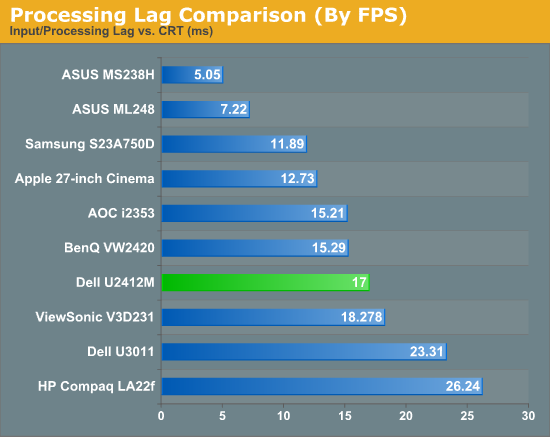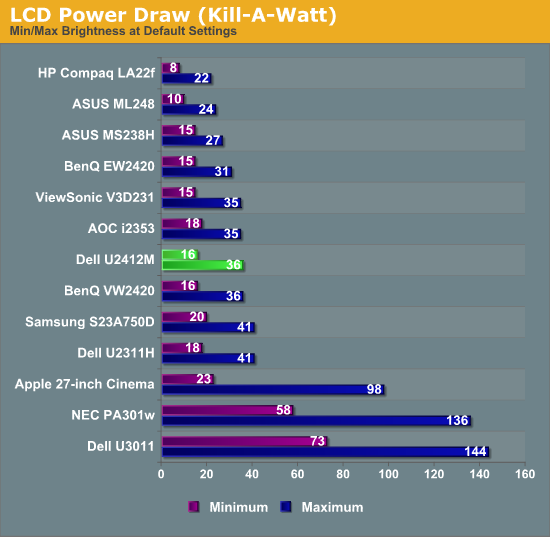Dell U2412M - 16:10 IPS without Breaking the Bank
by Chris Heinonen on February 28, 2012 9:00 AM ESTDell U2412M Input Lag and Power Use
For testing lag, I am trying a new solution to our previous testing method. I’m trying out SMTT, which is designed specifically for measuring lag in LCD displays. Using DirectX it manages to push over 1,000 frames per second to a display, allowing for millisecond accuracy instead of relying on time demos that often run well below that threshold. Using this method, we can actually determine two different values: The input lag for the LCD to initially respond, and then the total lag from when the new frame is received to when it is completely drawn and at full brightness. This last one is the overall important value, as it is what gamers would be most concerned with. It’s important to have as low an "input lag" as possible so that even if the screen isn’t fully drawn yet (the pixels will be changing over) you will be able to begin to get that feeling of responsiveness.

Here we see that the overall lag value measured OK, at 17ms. The input lag, which was also measured, was just under 2ms, which indicates that the Dell responds very quickly, and then it’s just a matter of the pixel response time. One thing to keep in mind here is that the 17ms response time is the total time from input to peak brightness, and then it takes 15ms to fall back to another value. When I actually look at the test subjectively and not objectively, you can certainly see the change in the pixel after 7-8ms of time. So I could report it as 8ms of lag, as that’s about what I think you would experience in a real world situation, but the worst case scenario seems to be 17ms, which is what I’m choosing to report as that’s the objective number.
The CRT still comes in perfect, and that’s what the LCD should aim to do; picking a number that gives a better result, even if it might be more applicable to the real world, feels like cheating. Perhaps we will get a future display technology (like OLED or CrystalLED that I saw at CES this year) that will bring us back to CRT response times, but until that happens I’m going with the objective, worst case measurement. I will report the “real world estimate” along with it, though, so you can use that for your own judgment. Please let me know what you think of this in the comments section.
I made the assumption that with a larger panel and the 300 nits of light output that the Dell would not be the most eco friendly panel I had seen. Happily I found this to not be the case. It drew just 36 watts at maximum brightness and only 16W at minimum brightness, less than even the 23” Dell U2311H from last year. I don’t know if it is more efficient LED lights, or a more transparent panel that allows more light through, but Dell did a good job keeping the power use low on the U2412M.











143 Comments
View All Comments
bioffe - Tuesday, February 28, 2012 - link
I find this article disturbing because it doesn't mention this monitor's predecessor U2410 which seems to be much better monitor for $150 dollars more. It's putty how Dell destroyed its high end model, and went to monetize its reputation. Dear Anand, I want to see how it measures to u2410.ImSpartacus - Tuesday, February 28, 2012 - link
I think Dell still sells the U2410. The U2412M is complimentary.I agree that the naming scheme is weird, but both monitors can coexist.
Death666Angel - Tuesday, February 28, 2012 - link
Considering the 60% price difference and that the 2410 is still being sold, I don't see why the 2412 is necessarily the successor. I think both monitors are targeting different consumers.cheinonen - Tuesday, February 28, 2012 - link
There isn't a review unit of the U2410 available at the moment, as I checked, so I could compare the two. They do fit into different realms, and can easily coexist at the same time, but the naming scheme is very, very hard to understand.Touche - Tuesday, February 28, 2012 - link
Much better for what? 2412 has better blacks, higher contrast, is sRGB which many find an advantage, has less input lag and is a bit faster. Head to tftcentral and prad for detailed comparisons.Oxford Guy - Tuesday, February 28, 2012 - link
The U2410 is competing in a different space.It has better uniformity.
It has a better color gamut.
It has worse contrast ratio.
It has a higher price.
Sufo - Wednesday, February 29, 2012 - link
U2410 has an sRGB profile...sethsez - Thursday, March 8, 2012 - link
It does have an sRGB profile. It's very inaccurate, as sRPG profiles on 10-bit monitors tend to be. If someone is doing work primarily for web-based content, a 10-bit monitor isn't just a waste, it's potentially detrimental.vectorm12 - Tuesday, February 28, 2012 - link
Greay review unfortunately I'm looling for something with higher resolution these days. For my kind of workload 2560x1440 have turned out to be the bare minimum. I recently bought 2x u2711 to replace 3x 1920x1080 Samsungs. I'd love to see some eIPs panels reach that size and preferably higher pixeldensities.cwolf78 - Tuesday, February 28, 2012 - link
Does this guy come off as a snobbish bitch to anyone else?